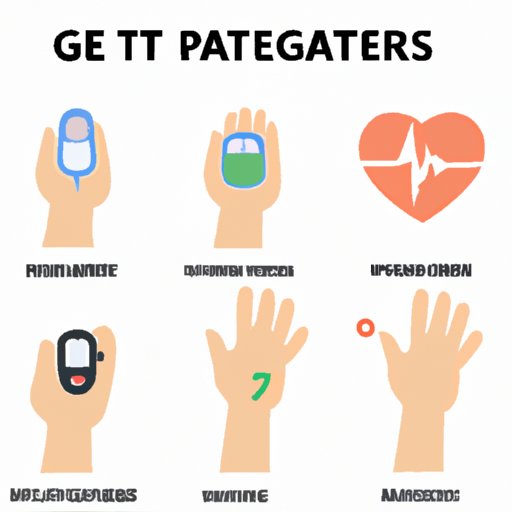
Introduction
Prediabetes is a condition that occurs when blood sugar levels are higher than normal, but not yet high enough to be diagnosed as type 2 diabetes. It’s estimated that over 88 million adults in the United States have prediabetes, but many don’t even know it. Recognizing the early symptoms of prediabetes is crucial in preventing the development of type 2 diabetes and the serious health complications that come with it.
Prediabetes: How to Recognize the Early Symptoms
Prediabetes happens when the body becomes resistant to insulin, which is the hormone responsible for regulating blood sugar levels. Over time, if not treated, the body may not be able to produce enough insulin to keep blood sugar levels normal, leading to type 2 diabetes. There are certain risk factors that increase the likelihood of developing prediabetes, such as being overweight or obese, leading a sedentary lifestyle, and having high blood pressure and cholesterol levels.
Getting regular check-ups with a healthcare provider is vital in identifying and monitoring prediabetes. It’s important to speak with a healthcare provider about your risk factors for developing the condition, as well as any concerning symptoms you may be experiencing.
7 common signs of prediabetes to watch out for
Here are 7 common symptoms of prediabetes to watch out for:
1. Increased thirst and frequent urination
Feeling thirsty all the time and needing to urinate frequently, especially at night, can be an early sign of prediabetes. This occurs because the kidneys are working harder than normal to filter out excess sugar in the blood.
2. Fatigue and weakness
Feeling tired or weak even after getting enough sleep may be a sign of prediabetes. This occurs because the body isn’t able to use sugar effectively for energy.
3. Blurred vision
Blurry vision or difficulty focusing can be a symptom of prediabetes. This occurs because high blood sugar levels can damage blood vessels in the eyes.
4. Slow-healing wounds or sores
Cuts and sores taking longer than usual to heal can be an indication of prediabetes. High blood sugar levels can slow down the healing process and make it harder for the body to fight off infections.
5. Numbness or tingling in hands and feet
Numbness, tingling, or a burning sensation in the hands and feet can be a sign of prediabetes. This occurs because high blood sugar levels can damage nerves and blood vessels.
6. Darkened skin on neck or armpits
Darkening of the skin, especially in areas like the neck or armpits, can be an early sign of prediabetes. This occurs because insulin resistance can cause changes in the skin’s pigment.
7. Sudden weight loss or gain
Sudden weight changes, whether gaining or losing weight, can be a sign of prediabetes. This occurs because the body isn’t able to use sugar effectively for energy, causing it to turn to other sources like muscle tissue.
Are you at risk for prediabetes? Look for these early warning signs
In addition to the symptoms above, there are certain risk factors that increase the chances of developing prediabetes:
1. Family history of diabetes or prediabetes
If someone in your family has diabetes or prediabetes, you may be at a higher risk of developing the condition.
2. Being overweight or obese
Carrying extra weight, especially in the abdomen, can increase the chances of developing prediabetes.
3. Leading a sedentary lifestyle
A lack of physical activity and exercise can increase the risk of developing prediabetes.
4. High blood pressure and cholesterol levels
Having high blood pressure or cholesterol levels can increase the chances of developing prediabetes.
5. Smoking and excessive alcohol consumption
Smoking and drinking alcohol excessively can contribute to the development of prediabetes.
Prediabetes symptoms: What to look for and when to see a doctor
Monitoring blood sugar levels is an important component in identifying and managing prediabetes. A healthcare provider can perform a fasting blood sugar test to determine if someone is experiencing high blood sugar levels. If symptoms persist, it’s important to see a healthcare provider to discuss treatment options, which may include lifestyle changes and medication.
Identifying the early signs of prediabetes: A helpful guide
Keeping a symptom journal can be a helpful way of tracking any concerning signs or symptoms. Additionally, tracking blood sugar levels regularly can help identify any changes in blood glucose levels. Making lifestyle changes such as increasing physical activity, adopting a healthy diet, and quitting smoking can also help prevent the progression of prediabetes.
How to spot the signs of prediabetes before it’s too late
Early detection and intervention can significantly reduce the chances of prediabetes developing into type 2 diabetes. By making lifestyle changes and following a healthy diet, the risk of developing prediabetes can be reduced. It’s important to speak with a healthcare provider about any concerning signs or symptoms in order to receive early intervention.
The early warning signs of prediabetes you need to know about
In recap, the early symptoms and risk factors of prediabetes include:
- Increased thirst and frequent urination
- Fatigue and weakness
- Blurred vision
- Slow-healing wounds or sores
- Numbness or tingling in hands and feet
- Darkened skin on neck or armpits
- Sudden weight loss or gain
- Family history of diabetes or prediabetes
- Being overweight or obese
- Leading a sedentary lifestyle
- High blood pressure and cholesterol levels
- Smoking and excessive alcohol consumption
If any of these symptoms or risk factors apply to you, it’s important to speak with a healthcare provider about monitoring and managing blood sugar levels.
Conclusion
Recognizing the early symptoms of prediabetes can significantly reduce the chances of the condition progressing to type 2 diabetes. It’s important to stay proactive about monitoring health and making lifestyle changes in order to prevent prediabetes. By staying informed and working with a healthcare provider, prediabetes can be managed effectively.




